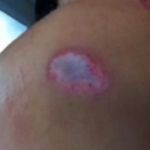What is Lactose intolerance?
Lactose intolerance, in general terms, is a condition when the body is unable to digest lactose. Lactose is a kind of natural sugar present in dairy products and milk. People who cannot digest dairy products develop this condition. When lactose passes through colon without getting digested, it results in problems like bloating, gastric issues and pain in belly. This condition is commonly found in adults.
Lactose intolerance is caused due to deficiency of lactase which is produced in small intestine. After having undergone surgery to remove a part of intestine or having conditions like stomach flu and lifelong diseases like cystic fibrosis, the small intestine might stop making enzyme called lactase. Lactase breaks down lactose into simpler forms: glucose and galactose and thus helps to digest it.
Signs of lactose intolerance
Depending on how much lactase the body makes, symptoms of lactose intolerance can be severe or mild. The signs are visible after ½ to 2 hours of having milk or dairy products. The most common symptoms of lactose intolerance are:
- Gas
- Abdominal bloating
- Gurgling sounds or pain in belly
- Diarrhoea
- Throwing up
- Pain or cramps
- Nausea
Generally people get confused with the symptoms and do not recognize their body’s intolerance to dairy products. In order to prevent this, you can avoid eating milk products and check if symptoms go away. And if they go, start consuming dairy products in small quantity and see if symptoms come again.
If you feel sick after having a glass of milk or any milk product once or twice, this does not confirm your lactose intolerance but you might be susceptible to this disorder. Some people with lactose intolerance may tolerate small amount of lactose.
Lactose intolerance in babies and toddlers
In very few cases, babies are born with lactose intolerance. If a person is born with this condition, he cannot eat or drink anything containing lactose. In another case, premature birth may be the reason for lactose intolerance. In premature delivery, the baby is not able to make lactase yet. This is a temporary intolerance which goes away after some time.
Milk and milk products are a great source of calcium required for growth and repair of bones. Inadequate consumption of calcium leads to fragile bones and poor growth of mind and body in children. Therefore it becomes important to consult a dietician for the diet plan that would limit the consumption of lactose, without compromising with their nutrient intake.
Lactase deficiency begins only after the age of 2 and grows gradually with time. Majority of the children having lactase deficiency do not develop symptoms of lactose intolerance until adolescence or adulthood. Some children may also inherit gene from their parents making it probable for them to develop lactase deficiency.
Tests for lactose intolerance
It is difficult to diagnose this condition by merely seeing the symptoms. It is possible that people mistake their digestive irregularities with the lactose intolerance. Conditions like bowel syndrome have symptoms similar to lactose intolerance.
Your doctor may examine your case and recommend not having milk and milk products for some time to see if these symptoms persist. Tests can clearly determine the condition. There are two tests used to check lactose intolerance.
1) Hydrogen Breath Test: The person is given beverage with good quantity of lactose and then the breath is checked to measure hydrogen. Generally, low level of hydrogen is detected but a person having lactose intolerance gives large amount of hydrogen in each breath because undigested lactose produces high levels of hydrogen. Certain medications, smoking and eating habits may affect the test result. Therefore eating habits and medications you eat should be discussed with the doctor beforehand.
2) Stool Acidity Test: This test is specifically for infants and kids to determine the amount of acid present in the stool. Since undigested lactose produce lactic acid and fatty acids, it can be detected from the stool.
Treatment to manage symptoms of lactose intolerance
Since lactose intolerance is caused due to dairy products in the diet, therefore its symptoms can be managed with dietary changes. Most people can tolerate small quantity of lactose in their diet so they can take milk products in smaller amounts. Basically, the amount of lactose that can be consumed without symptoms may vary from one individual to other.
Lactose-free milk products can be taken for those who have high intolerance to dairy products. Lactose-free milk is easily available in the market and it remains fresh for longer duration. Ask your doctor or dietician for the nutrition and diet plan so that you consume lactose only in prescribed quantity. This is because calcium and Vitamin D are present in dairy products in large quantities and these nutrients are important especially for pregnant women and children.
However some people experience lactose intolerance symptoms even after introducing dietary changes; they should be given over-the-counter lactase enzyme tablets or drops. Taking these tablets or drops along with milk or milk products you consume, will largely increase the tolerance with lactose.



